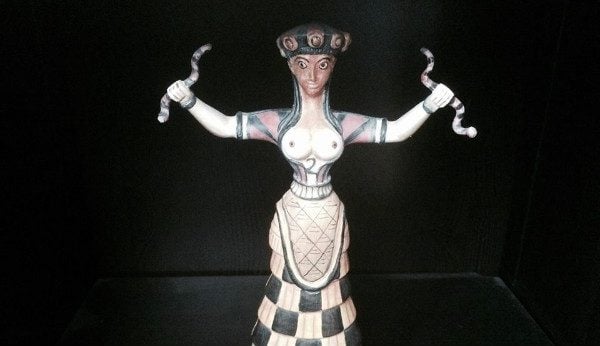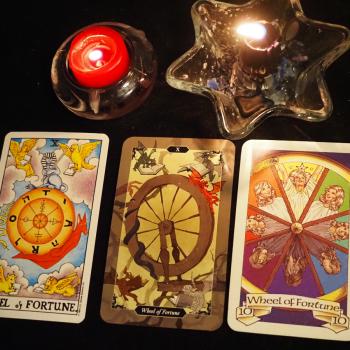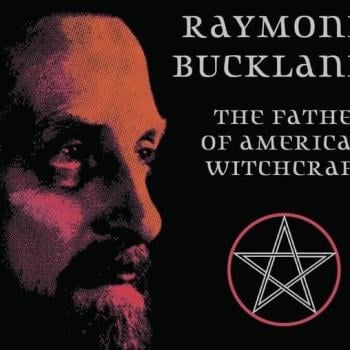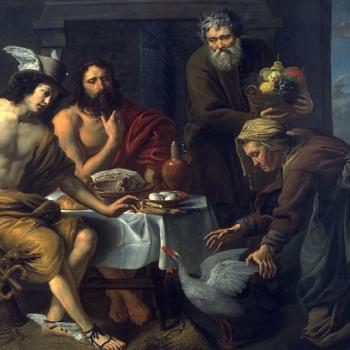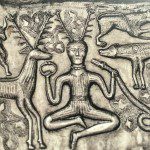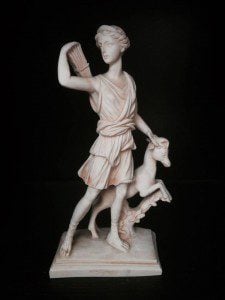 A couple of weeks ago I somehow ended up in a discussion about The Charge of the Goddess on social media. I think the argument was about “who wrote the Charge?” a question which is more complex than most people realize. Generally when people talk about The Charge they are referencing Doreen Valiente’s prose version (or perhaps Starhawk’s version of it). Certainly it’s the most well known version of The Charge (and my personal favorite), but there are other versions, versions which predate Valiente’s by over fifty years in some cases.
A couple of weeks ago I somehow ended up in a discussion about The Charge of the Goddess on social media. I think the argument was about “who wrote the Charge?” a question which is more complex than most people realize. Generally when people talk about The Charge they are referencing Doreen Valiente’s prose version (or perhaps Starhawk’s version of it). Certainly it’s the most well known version of The Charge (and my personal favorite), but there are other versions, versions which predate Valiente’s by over fifty years in some cases.
I’ve always found the term “charge” provocative. Because it’s something we don’t use in mundane conversation it carries with it extra power. The term “charge” is a Masonic one and initially indicated a list of instructions. In Modern Witchcraft a “charge” is similar, but it comes with the authority of the gods themselves. When the High Priestess recites the Charge of the Goddess she is reciting no less than the words of The Lady herself. (Never mind that we can trace the origins of the Charge through several incarnations . . . . let’s just say it’s divinely inspired.)
The Charge of the Goddess was originally used for two purposes. Its first use was as an explanation of Witch religion and was read to initiates upon receiving their first degree. The Charge was later used as a “substitute” for the Goddess when drawing down the moon didn’t go exactly as planned. It’s still used for that latter purpose, but just as often its used in ritual simply because people like it. It’s about the only thing Wicca has that might be considered liturgy.
The first published version of The Charge of the Goddess appears in Charles Godfrey Leland’s Aradia: Or the Gospel of the Witches in 1899. Aradia allegedly documents an Italian Witch (or Strega) tradition and contains numerous spells along with some barebones material dealing with deity. Leyland’s Italian Witches honored the goddess Diana, the god Lucifer, and their daughter Aradia, who was seen as a protector and charged with teaching Witchcraft to the downtrodden.
The Witchcraft in Aradia is very different from what many of us practice. It’s extremely aggressive and contains curses and other sorts of magic we might consider harmful or unethical. According to the mythos of Aradia, Italy’s Witches were in conflict with Christianity and such aggressive steps were necessary to insure survival.
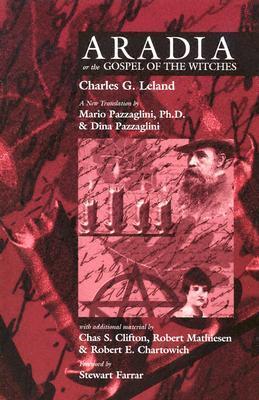 I have mixed feelings about Aradia. There’s a lot of evidence to suggest that the magic found within its pages is centuries old and represents a living tradition of folk magic. The religious and mythological elements are harder to quantify. If Aradia truly represents a Witch tradition, that tradition is most likely of a more recent vintage, and post-dates Christianity. It’s possible that it arose during the Renaissance, but it’s more likely to be a creation of the 19th Century.
I have mixed feelings about Aradia. There’s a lot of evidence to suggest that the magic found within its pages is centuries old and represents a living tradition of folk magic. The religious and mythological elements are harder to quantify. If Aradia truly represents a Witch tradition, that tradition is most likely of a more recent vintage, and post-dates Christianity. It’s possible that it arose during the Renaissance, but it’s more likely to be a creation of the 19th Century.
The proto-Charge in Aradia consists of the goddess Aradia directly addressing her early followers. It makes up the last bits of the book’s first chapter and its ending directly leads into chapter two “The Sabbat.” This is not a charge in the traditional sense, but so much of today’s Charge of the Goddess lies within it that I can’t help but call it a charge. Because the last few lines lead directly into the book’s second chapter I don’t use them when using the Aradia Charge in ritual, however I’ve included them here in parenthesis for thoroughness.
The Charge of the Goddess in Aradia:
“When I shall have departed from this world, whenever ye have need of anything, once in the month, and when the moon is full, ye shall assemble in some desert place, Or in a forest all together join to adore the potent spirit of your queen, my mother, great Diana. She who fain would learn all sorcery yet has not won its deepest secrets, then my mother will teach her, in truth all things as yet unknown. And ye shall all be freed from slavery, and so ye shall be free in everything; and as the sign that ye are truly free, ye shall be naked in your rites, both men and women also: this shall last until the last of your oppressors shall be dead. (And ye shall make the game of Benevento, extinguishing the lights, and after that shall hold your supper thus:)” (1)
In 1998 Mario and Dina Pazzaglini released a new translation of Aradia, working with Leland’s original notes. The differences aren’t all that striking but I think it’s worth including in this article. I have re-arranged a few lines here for clarity.
The Charge of the Goddess in Aradia
Re-translated by Mario and Dina Pazzaglini“When I will have left this world,
What ever it is you have need of,
Once a month, when the moon is full
You must come to a lonely place
In a forest all together,
And adore the powerful spirit of my mother Diana,
And whomever would like to learn Witchcraft
Who will not surpass her,
My mother will teach them all things
You will be free from bondage!
And in this way, you will all be free!
But, men and women will all be naked
Until every last one of the oppressors is dead,
(You will play the game of moccola Beneveto
And then you will make a supper like this:)”
The second “version” of The Charge of the Goddess dates back to the late 1940’s and shows up in Gerald Gardner’s Book of Shadows circa 1949. That text is generally known today as Ye Bok of Ye Art Magical, simply Ye Bok, and sometimes as BAM or The BAM (Bok Art Magical). I usually attribute this version of The Charge to Gardner, but who knows? It might very well predate him. What’s not in doubt are the documents that inspired it; namely the version of the Charge found in Aradia and the “Priestess Speech” from Aleister Crowley’s Gnostic Mass.
This version of the Charge was originally known as Lift Up the Veil, though I’ve heard it referred to as “Gardner’s Charge” on a number of ocassions. Most of it feels pretty familiar to those accustomed to the Valiente version, well at least until the last bit . . . .
Lift Up the Veil
“Listen to the words of the Great mother, who of old was also called among men Artemis, Astarte, Dione, Melusine, Aphrodite, Cerridwen, Diana, Arianrhod, Bride, and by many other names.”
“At mine Altars the youth of Lacedaemon in Sparta made due sacrifice. Whenever ye have need of anything, once in the month, and better it be when the moon is full, ye shall assemble in some secret place and adore the spirit of Me who am Queen of all Witcheries and magics. There ye shall assemble, ye who are fain to learn all sorcery, yet have not won its deepest secrets. To these will I teach things that are yet unknown. And ye shall be free from slavery, and as a sign that ye be really free, ye shall be naked in your rites, both men and women, and ye shall dance, sing, feast, make music, and love, all in my praise.
There is a Secret Door that I have made to establish the way to taste even on earth the elixir of immortality. Say, ‘Let ecstasy be mine, and joy on earth even to me, To Me,’ For I am a gracious Goddess. I give unimaginable joys on earth, certainty, not faith, while in life! And upon death, peace unutterable, rest, and ecstasy, nor do I demand aught in sacrifice.”
“Hear ye the words of the Star Goddess.”
“I love you: I yearn for you: pale or purple, veiled or voluptuous. I who am all pleasure, and purple and drunkenness of the innermost senses, desire you. Put on the wings, arouse the coiled splendor within you. ‘Come unto me.’ For I am the flame that burns in the heart of every man, and the core of every Star. Let it be your inmost divine self who art lost in the constant rapture of infinite joy. Let the rituals be rightly performed with joy and beauty. Remember that all acts of love and pleasure are my rituals. So let there be beauty and strength, leaping laughter, force and fire by within you.
“And if thou sayest, ‘I have journeyed unto thee, and it availed me not,’ Rather shalt thou say, ‘I called upon thee, and I waited patiently, and Lo, Thou wast with me from the beginning,’ for they that ever desired me shall ever attain me, even to the end of all desire.” (3)
The second half of Veil is where most of the Gnostic Mass material comes from, and most of that was later removed by Valiente:
The Priestess Speech from the Gnostic Mass
Aleister CrowleyTo love me is better than all things.
if under the night-stars in the desert thou presently burnest mine incense before me,
invoking me with a pure heart, and the serpent flame therein,
thou shalt come a little to lie in my bosom.
For one kiss wilt thou then be willing to give all,
but whoso gives one particle of dust shall lose all in that hour.
Ye shall gather goods and store of women and spices
ye shall wear rich jewels
ye shall exceed the nations of the earth in splendor and pride but always in the love of me, and so shall ye come to my joy.I charge you earnestly to come before me in a single robe,
and covered with a rich head-dress.
I love you!
I yearn to you!
Pale or purple, veiled or voluptuous,
I who am all pleasure and purple, and drunkenness of the innermost sense, desire you.
Put on the wings, and arouse the coiled splendour within you:
Come Unto Me!
To me! To me!
Sing the raptuous love-song unto me!
Burn to me perfumes!
Wear to me jewels!
Drink to me, for I love you!
I love you.
I am the blue-lidded daughter of sunset
I am the naked brilliance of the voluptuous night-sky.
To me! To me!
A small bit of Lift Up the Veil was included in Gardner’s 1954 book Witchcraft Today. It’s not incredibly different from the version included above but there are some subtle variations. The bit of Veil included in Witchcraft Today appears in the middle of a paragraph so I’ve included the sentence introducing it and some of what Gardner says about it afterwards:
“Before initiation a charge is read beginning: ‘Listen to the words of the Great Mother, who of old was also called among men Artemis, Astarte, Dione, Melusine, Aphrodite and many other names. At mine altars the youth of Lacedaemon made due sacrifice. Once in the month, and better it be when the moon is full, meet in some secret place and adore me, who am queen of all the magics . . .
For I am a gracious goddess, I give joy on earth, certainity, not faith, while in life; and upon death, peace unutterable, rest and the ecstasy of the goddess. Nor do I demand aught in sacrifce . . . . . . . ‘ I am forbidden to give any more; but if you accept her rule you are promised various benefits and admitted into the circle, introduced to the Mighty Dead and to the cult members.” (4)
Doreen Valiente’s version of The Charge of the Goddess dates back to sometime around 1957 and was inspired by Valiente’s desire for a less Crowley influenced charge. She writes about this in The Rebirth of Witchcraft:
” . . . with the publication of his book Witchcraft Today in 1954 and his lectures and appearances on television, more and more people began contacting Gerald and wanting to join. Gerald began to realize that he had a real chance of reviving the Old Religion, and he wanted to gain popular acceptance for it. I pointed out to him that in my opinion he would never succeed in doing this so long as the influence of the late Aleister Crowley was so prevalent and obvious within the cult . . . Crowley may have been a brilliant writer and a splendid poet but as a person he was simply a nasty piece of work . . . . Gerald’s reaction was ‘Well, if you think you can do any better, go ahead.’ I accepted the challenge and set out to rewrite ‘The Book of Shadows,’ cutting out the Crowleyanity as much as I could and trying to bring back to it what I felt was, if not so elaborate as Crowley’s phraseology, at least our own and in our own words. I felt that the words from Aradia qualified in this respect, so I retained them as the basis for my new version of ‘The Charge’ . . . . “(4)
Valiente’s reworked Charge was originally a poem, later rewritten in the prose form most of us are familiar with today:
Charge of the Goddess (Poem)
Doreen ValienteMother, darksome and divine,
Mine the scourge and mine the kiss
Five-point star of love and bliss
Here I charge ye in this sign.Bow before my spirit bright
Aphrodite, Arianrhod,
Lover of the Horned God,
Queen of Witchery and nightDiana, Brigid, Melusine
Am I named of old by men,
Artemis and Cerridwen,
Hell’s dark mistress, Heaven’s Queen.Ye who ask of me a boon,
Meet ye in some hidden shade.
Learn my dance in greenwood glade,
by the light of the full moon.Dance about mine altar stone.
Work my holy Magistry,
Ye who are fain of sorcery,
I bring ye secrets yet unknown.No more shall ye know slavery
Who tread my round on Sabbat night.
Come ye all naked to the rite,
In sign that ye are truly free.Keep ye my mysteries in mirth
Heart joined to heart, and lip to lip.
Five are the points of fellowship
That bring ye ecstasy on Earth.No other law but love I know,
By naught but love I may be known,
And all that liveth is mine own
From me they come, to me they go. (5)
There is another rhyming version of The Charge by Valiente, but I can’t find it any source I feel comfortable quoting. That version was apparently written in the early 1960’s. It’s not hard to find if you are interested in doing a little digging.
The more popular Valiente prose version of The Charge was written sometime after the rhyming Charge. Apparently this was done at the request of Doreen’s coven-mates. Valiente elaborates in The Rebirth of Witchcraft:
“However, people seemed to have some trouble difficulty with this, because of the various goddess-names which they found hard to pronounce. Also, they could not understand the word ‘magistry,’ which I use in the same sense as the famous writer of weird tales, Arthur Machen, used it. So I wrote what has come to be known much better as the prose version of ‘The Charge’ and which in various versions seems to have been copied all over the world.” (6)
Due to copyright concerns I’m not going to reproduce the prose version here, but it’s easy to find online (click here) and most of you reading this probably have a copy in your own library. I will point out that Valiente never really did get rid of the Crowleyanity, she simply moved it around to some degree. More obvious borrowings from The Gnostic Mass were removed but a lot of Crowley remains. Valiente also used some materials from The Golden Dawn and even Christian liturgy. (7) Whatever the sources Valiente’s version is masterful, with a cadence and a power missing from earlier attempts.
Nearly as famous as Valiente’s version of The Charge is Starhawk’s adaption of it. The Starhawk version first shows up in The Spiral Dance (1979) and became the version of The Charge in many traditions. It’s not drastically different from the Valiente version, but it omits several lines that I think are important:
“There shall ye assemble, ye who are fain to learn all sorcery, yet have not won its deepest secrets; to these will I teach things that are yet unknown.”
” . . and before my face, beloved of Gods and of men, let thine innermost divine self be enfolded in the rapture of the infinite.” (8)
Adapting The Charge is certainly not of bounds, and in many ways reflects The Charge’s history, for it has been continuously adapted for over 100 years now. First showing up in Leland, and then Gardner, and then Valiente on three different occasions, and then most notably Starhawk not to mention the various versions amongst the Witchcraft community. Even my wife and I who love the Valiente version most of all, have added a few tweaks to the original over the years.
So who “wrote” The Charge of the Goddess? Obviously it’s a text with many different authors (Leland, Leland’s source for Aradia, Gardner, Gardner’s initiators?, Crowley, and Valiente . . . and that’s just for starters!) but without a doubt the version most familiar to people today was assembled by Valiente and for that she most certainly deserves the title of “author.”
Perhaps in the end though The Charge of the Goddess really did come from The Goddess. Over time bits and pieces that would help to articulate her mystery were released and composed until they eventually ended up in the form we know them best today. As a Goddess loving and believing Witch I’m comfortable with giving Her at least some of the credit.
NOTES
1. From Aradia by Charles Leland, first published in 1899. That quote originally appeared on page six but shows up on pages 132 and 133 of the Mario and Dina Pazzaglini edition (published by Phoenix Publishing, 1998). Sadly this version is out of print physically, but can still be picked up as an e-book.
2. The Pazzaglini translation appears on pages 360-362 of their book. They also include a note about Moccola di Benevento which is an Italian game that might go back to pagan anqituity. More curious are the various meanings of the word moccola, which can mean: swear, curse, or stub left by a burned-out candle.
3. This version of Lift Up the Veil comes from Aidan A. Kelly’s Crafting the Art of Magic (Book 1) published in 1991 by Llewellyn. You can find it on pages 52-54. I’ve read some criticisms of Kelly’s transcription of it, but I don’t have any other reputable sources for it in my library.
4. All of the Valiente quotes, including the poetic Charge are from her The Rebirth of Witchcraft published by Phoenix Publishing back in 1989. This quote shows up on page 61.
5. This is from Rebirth and quotes parts of pages 61-62. The Rebirth of Witchcraft is one of the best books on Wiccan/Witch history ever written. Go buy it!
6. Did Valiente write this book knowing that people would be quoting it like this over twenty-five years later? No, I don’t think so, but it’s one of the reasons this book is so damn important. Things she thinks are throw-away tidbits are of huge importance to those of us who are Craft-history nerds. This is from page 62, again go buy this book.
7. For a line by line dissection of Valiente’s Charge take a look at Sorita d’Este and David Rankine’s Wicca: Magickal Beginnings. It’s pretty extensive. I’m quoting from page 140 of that book with the mention of The Golden Dawn and Christian liturgy.
8. I took those quotes from Doreen’s Charge out of A Witch’s Bible by Janet and Stewart Farrar, published by Phoenix Publishing in 1996. That material was originally published as Eight Sabbats for Witches in 1981. The quotes come from page 43.


